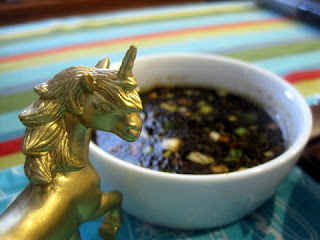Who doesn't love a
potsticker? We had to make some. This makes a ridiculous amount of
filling so either get more wrappers or throw it in with some fried
rice. The dipping sauce is the base we used. I know we added a lot of
other stuff to it. Go crazy and make it to taste.
Guo Tie and Dipping Sauce
via Traditional Chinese Recipes:
Makes
so many (at least 20)
1 lb. ground pork
1 lb. napa cabbage
2 green onions, white and green portion minced
1 Tb. minced ginger
1 Tb. Shao Xing rice wine or dry sherry
2 Tb. sesame oil
1 Tb. soy sauce
1 tsp. salt, to taste.
1 Tb. cornstarch
¼ to ¾ c. chicken or pork stock
At
least 20 gyoza wrappers
Dipping
Sauce:
½ c. soy sauce
¼ c. sweet soy
2 Tb. Shao Xing wine or dry sherry
2 Tb. rice vinegar, or Qing Kiang vinegar
1½ Tb. finely minced ginger, steeped in ¼ c. hot
water for 30 min.
Make the dipping sauce first. Mix all of the ingredients together plus whatever fun stuff you come up with and set aside.
Separate cabbage leaves
and blanch in boiling water for about two and a half minutes. Allow
to cool. Wring out the water from the blanched cabbage using a
kitchen towel, and chop to 1/4" to 1/2" pieces. Mix this
together with meat and all remaining filling ingredients, adding
cornstarch last. Add chicken or pork stock slowly as you mix the
filling in one direction. Continue adding stock until mixture is
visibly wet and "sloppy." If you've overdone the addition
of liquid, and the filling is impossible to handle when making the
dumpling, add more cornstarch to firm it up. Keep in mind that the
filling will firm up when it is refrigerated. Covered, the filling
can be refrigerated for up to five days. When you are ready to fill
the dumplings, make one and boil it to test the flavor and texture,
and making any adjustments at that time.
Moisten the edge of a
wrapper all the way around with water, then using a spoon or
chopsticks, place approximately a heaping tablespoon of filling in
the center. Fold the skin, and before the edges touch, grasp them
with your right thumb and index finger, and beginning at the fold,
pleat the outside edge, guiding the dough with your left fingers and
press it to the inside. As you do this from right to left, you will
create a dumpling, which, when set aside on a piece of parchment
paper or floured board, will form a flat side perfect for browning
when making potstickers. With a little practice, this process will
become second nature.
Pre-heat a flat bottomed,
well-seasoned pan or skillet on medium heat; add peanut oil to a
depth of approximately 1/16 inch. Arrange guo tie close together with
the flat side of the dumpling in the oil. Cover and cook for about 3
minutes; after a couple of minutes, lift one or two of the dumplings
to see how the browning is progressing. Add water to a depth of about
1/8”—be careful, this will spatter. Cover again and turn heat
down to low or medium low, for about 4 minutes. After the potstickers
are well steamed, uncover and cook for another two minutes, to
evaporate any remaining water and to re-crisp the dumplings. Remove
dumplings to a platter, and serve with browned sides facing up.
Like with frozen
potstickers, these stuck to the pan. It's a matter of getting them
before all the oil is absorbed into the potsticker itself. The timing
might be hard, but the food is delicious. Made all the better when
you have a unicorn friend to hang out with your dumplings.
I saved the best for last.
Check out the amazing bao we made tomorrow.
.jpg)








No comments:
Post a Comment